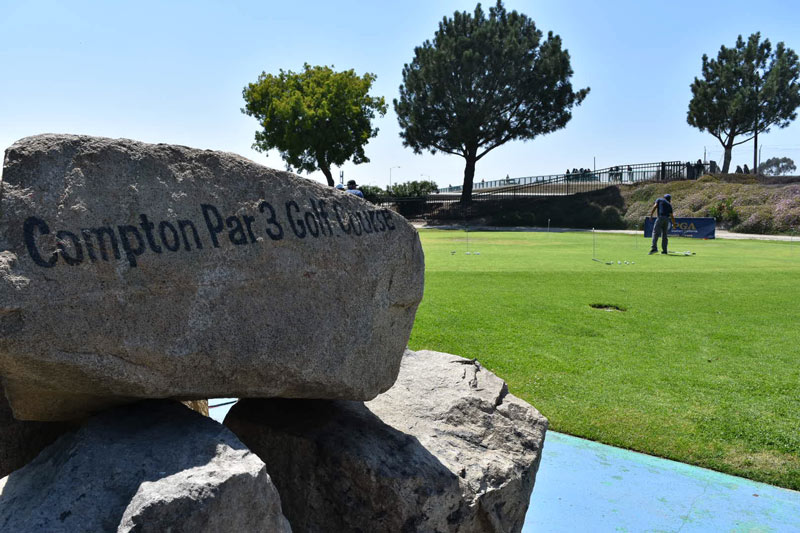
The Compton Par 3 Golf Course, a nine-hole track operated by the city of Compton, Calif., was built in 1958. Photo courtesy of the Southern California PGA
When Dan Pollack volunteered for a service project to help revitalize the Compton Par 3 Golf Course, few likely would have blamed him for envisioning a nearly worst-case scenario.
The Compton Par 3 — the only golf course in the Los Angeles suburb of Compton — was being maintained by a skeleton crew of two who had only scant training specific to golf course agronomy. The irrigation system was aged, the maintenance budget miniscule. Because of the threat of vandalism and theft, maintenance equipment couldn’t be stored on-site. And that was before the coronavirus pandemic forced the Compton Par 3’s closure in March 2020.
And yet, to Pollack’s eye, something workable was at hand.
“Honestly, it was not massively horrible,” says Pollack, assistant superintendent at Wilshire Country Club in Los Angeles and a seven-year GCSAA member. “The teeing areas were the worst part about it, since there were no mats in place. There needs to be some tree work, some pruning and trimming. A lot of the teeing areas are faded and thin. The fairways and rough ... they let the grass grow high, but it’s not terrible.
“The greens ... I think they used to have Poa greens, but now I’d call it about 80% kikuyugrass. There was definitely a little thatch, and there are some low areas here and there. To be honest, it’s not a bad little track at all. It just hasn’t been culturally maintained where it needed to be.”
And that’s where the GCSA of Southern California came in. The Southern California PGA had contacted the GCSASC in fall 2020 to see whether the chapter could lend an agronomic hand as part of a bigger project to turn the Compton Par 3 into a sort of youth-focused community hub. Pollack and Ryan MacNair — assistant superintendent at Santa Ana Country Club and a five-year GCSAA member — serve as assistant superintendent liaisons to the GCSASC board of directors, and on Oct. 23, 2020, they paid the Compton Par 3 a visit to determine its condition and devise a plan to prolong its health.
Some of Pollack and MacNair’s recommendations were pricey — like an irrigation renovation — but some were within reach. They’d hoped to return to the course with a full volunteer crew last fall, but logistics postponed that work visit until this spring.

An employee from Turf Time West aerifies a green at the Compton Par 3 Golf Course during a workday in June 2021. Photo by Dan Pollack
Through generous donations of time, services and products, a hodgepodge crew of assistant superintendents, vendors, product reps and city workers aerified and heavily topdressed the nine greens of the Compton Par 3 on June 17, 2021. When they departed, they left behind nearly half of the 50 tons of donated greens-grade topdressing sand, eight bags of donated fertilizers, recycled hitting mats for the teeing areas, a plan for how to maintain the property in the months ahead, and, just maybe, hope that the idea of a golf-centric, youth-focused community hub might just happen after all.
“I’m really happy that we were able to help out,” Pollack says, “and not just from a feel-good standpoint. The amount of work we did, how we did it and how it looked at the end — I feel it will be really, really great for the health of the golf course.”
It might be even better for the health of the community.
A prime location and a grand plan
Eddie Rodarte is the junior golf manager and manager for outreach and inclusion for the Southern California Section of the PGA of America. He has represented the SCPGA at various youth golf clinics, including one held at the Compton Par 3. While there, Rodarte noticed the course abutted both Clinton Elementary School and Dominguez High School.
“I remember asking, ‘How often do those kids play here?’” Rodarte recalls. “I was told, ‘They don’t play here.’ ‘Why not?’ They said, ‘There’s no golf for kids at that level.’ So I went to Tom Addis, the SCPGA’s executive director, and he said, ‘What do you want to do about it?’ I said that I’d like to figure out the reason, and he said to run with it.”

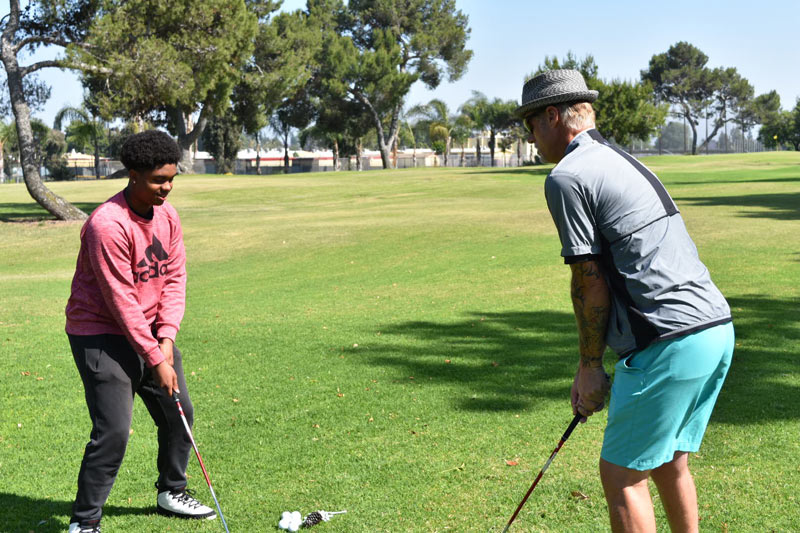
PGA professional Brett Lang works with students from the Compton Unified School District during a clinic at the Compton Par 3 Golf Course in May 2019.
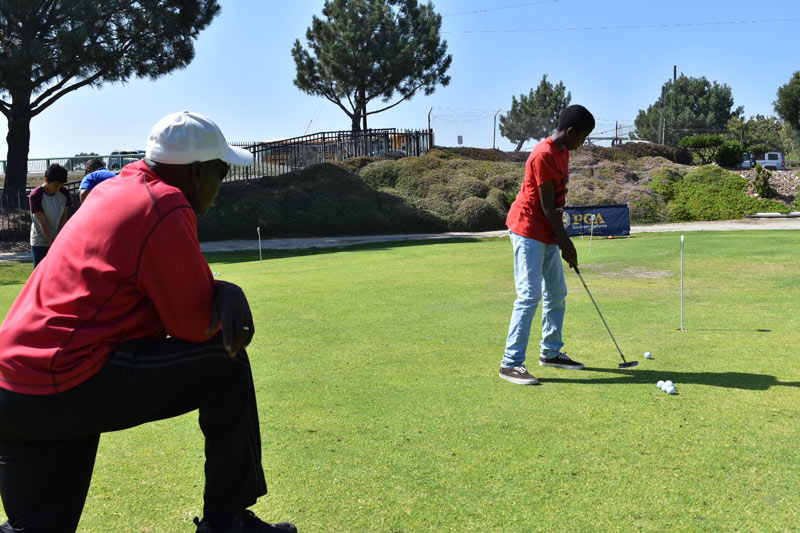
Golf instructor Luis Batson, who teaches junior golf in the Los Angeles area, guides a budding golfer during the Southern California PGA’s May 2019 clinic at the Compton Par 3. Photos courtesy of the Southern California PGA
Working with the city and the Compton Unified School District in 2019, Rodarte learned none of the district’s four high schools had a golf program. He contacted the principals at each and got permission to conduct demonstrations in each school’s gymnasium.
“We just went in and said, ‘This is golf,’” Rodarte says. “We laid it out for them, what was expected of them. I told them they could play golf as an alternative. Not everybody is going to play basketball or baseball or soccer. Golf is a viable alternative for kids who aren’t that type of athlete. The opportunities from golf are huge. To me, it’s kind of a passion. I like growing the game. After those four demonstrations, 57 kids walked up to me and gave me their names and said, ‘I want to be on the golf team.’”
Watch: Pro golfer Aaron Grimes, a Compton native, visited the Southern California PGA’s clinic for Compton Unified School District students held at the Compton Par 3 Golf Course on Oct. 29, 2019:
Picturing initially after-school club play — and possibly seeking sanctioning from the California Interscholastic Federation later on — Rodarte landed commitments from coaches at each high school to volunteer as golf coaches too. He solicited donations of clubs, shoes, balls, towels and tees. And he secured the Southern California GCSA to get the course’s greens in better shape.
“The whole thing was ready to go,” he says. “Then COVID hit.”
Just as the pandemic delayed the maintenance workday, it postponed the launch of Rodarte’s grow-the-game initiative. But it did little to quell his enthusiasm.
“My hope is, after this is done, after maybe a couple of years, I hope we can raise funds and make a computer lab and learning center there,” Rodarte says. “Maybe it could be a place kids go after school to do their homework, then after their homework, they can go play nine holes. Hopefully for some of them, golf can be a path to something better.
“You know, I live in Orange County — Yorba Linda. Compton isn’t even 23 miles away, but it’s like a different world. It shouldn’t be that way just because of a ZIP code. I’d like for this one day to become a model of the way things can be. If you can do it in Compton, you can do it in Chula Vista. You can do it anywhere.”
Lending time, talents and resources
Rodarte doesn’t mince words when describing the Compton Par 3.
“It’s not in the best part of town,” he says. “One day, a maintenance guy came into work. The tractor was gone. Somebody tried to steal it. They found it in the river.”
And that was in better times. Compton closed the course on March 17, 2020, because of the pandemic. Rodarte says job losses and cutbacks hit the Compton Parks and Recreation Department, and that trickled down to the golf course.
“They’re down to two dedicated personnel on-site to oversee the whole golf course,” he says. “They have irrigation issues and pump problems. They don’t know how to fertilize. They don’t have any funding. They don’t have much know-how, but they have a lot of heart. They’re great guys, and they want to see the course succeed.”
Working restricted hours and forced to transport equipment to and from the course daily, the two-person crew performed only essential maintenance through 2020. When Pollack and MacNair first visited last October, they found proof of aerification and topdressing, but neither, according to the staff, had been done at any point in the previous eight years. Greens had accumulated thatch of 1½ to 2½ inches. The kikuyugrass fairways were maintained at 3 inches, with longer roughs, but Pollack says there is no distinction between where fairway contours meet rough, and according to the maintenance team, there never has been. Staff mows once a week.
Pollack and MacNair figured the biggest bang for the buck would come from aerifying with 5/8-inch hollow tines down 2 to 3 inches and following up with heavy topdressing. They could justify such an aggressive approach because the course was (and still is) closed.
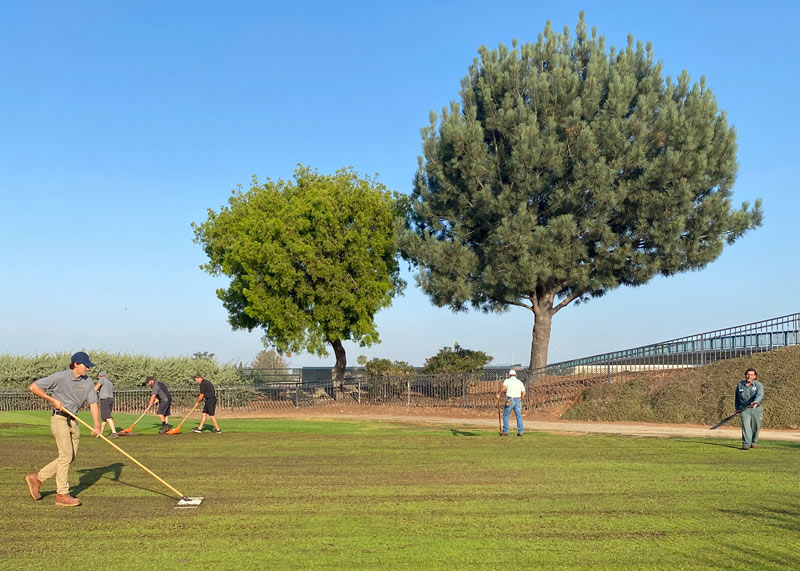
Post-aerification cleanup on a Compton Par 3 green. Those pitching in included volunteers from John Deere, DryJect Southwest and the Southern California PGA.
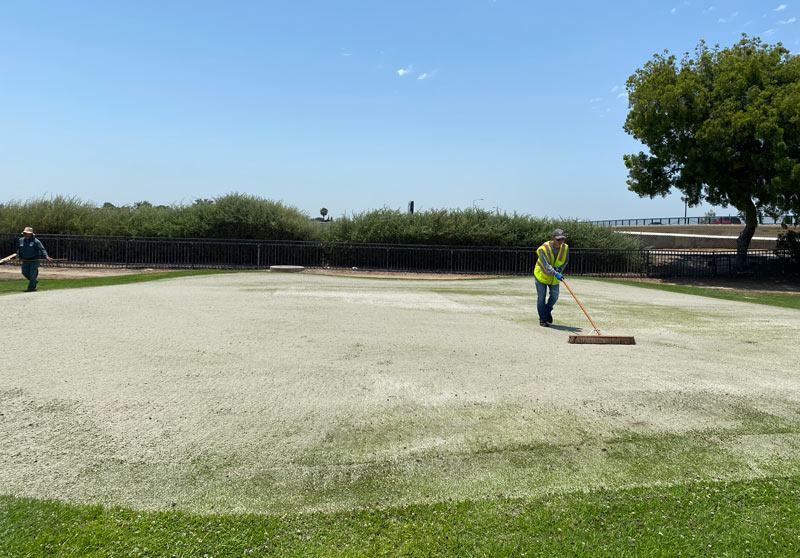
A worker with the city of Compton brushes topdressing sand into the sixth green. On the left is Mark Jones, one of just two regular caretakers of the Compton Par 3. Photos by Dan Pollack
Several local businesses — and Pollack’s course — contributed mightily.
A local John Deere dealer and his driver helped transport machinery and stayed all day to lend a hand. Two workers from Turf Time West punched the holes. A pair of workers from DryJect Southwest volunteered labor and managed to procure driving range mats from another course where they had worked. Those mats will be installed at the Par 3 to serve as teeing mats. A local Harrell’s rep donated fertilizer, and P.W. Gillibrand Co. Inc. donated the sand.
“I brought a lot of hand tools from my own golf course,” Pollack says. “They didn’t have enough shovels. And other people were able to make contributions. But without those companies being willing to do what they did, none of that stuff would have happened.”
Editor’s note: Abandoned houses and overgrown lots have given way to a golf course in a Kansas City, Mo., neighborhood thanks to the efforts of a lifelong resident and support from the larger golf community. Read more in Urban renewal: Harris Park brings golf to Kansas City neighborhood.
Pollack and MacNair have remained in contact with the Compton Par 3 staff. The assistant superintendents have outlined a fertilization schedule, and they plan to return to the course for another round of topdressing and to assist with the installation of the tee mats.
Though the course remains closed, its opening might be near.
“While we were there, a councilwoman came out to see what we were doing,” Pollack says. “We talked. She’s going to try to push the city to open up as soon as possible. The course is right off the highway. We had the gates open and a lot of cars and trucks in there. While we were working, two or three different people wandered in. They didn’t have clubs or anything, but they wondered what was going on. They all said, ‘Please tell me you’re opening back up? C’mon, you gotta be opening back up.’ The local people are getting antsy and want to play.”
Andrew Hartsock is GCM’s managing editor.